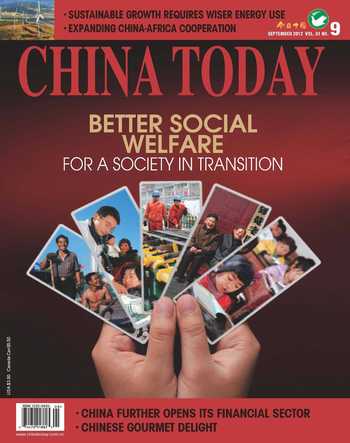Chinese Economy:On the Path of Scientific Development
By HU JIANGYUN
SINCE its entry into the WTO at the end of 2001, China has merged with the world economy and has seen rapid economic growth. By the end of 2011, Chinas GDP went up from RMB 11 trillion to RMB 47.2 trillion, with an average annual growth of 10.4 percent over the past decade.
As a result, living standards have greatly improved. In that decade, Chinas GDP per capita increased from RMB 8,622 to RMB 35,083, representing an average annual growth of 9.7 percent. According to statistics of the World Bank, in the same period Chinas gross national income (GNI) per capita increased almost fivefold, raising the country from lower middle income to middle income status.
China has also adjusted its economic structure. From 2001 to 2011, the proportions of the secondary and tertiary industries in the economy have increased, and the countrys economy is now driven by consumption as well as investment and export.
China has also become a large trading nation. From 2001 to 2011, Chinas goods exports surged from US $266.1 billion to US $1.8986 trillion and the countrys share of total world goods exports rose from 4.3 percent to 10.4 percent, rendering China the largest goods exporter in the world. In the same period, Chinas goods imports escalated from US $243.6 billion to 1.7435 trillion, with its share in the worlds total up from 3.8 percent to 9.5 percent. China has become the second largest goods importer, only behind the U.S. In the 10 years, Chinas service exports soared from US $32.9 billion to US $182 billion, with its share in worlds service exports up from 2.3 percent to 4.4 percent and its global ranking from 13th to fourth place. Chinas service imports grew from US $39 billion to US $236.5 billion, with its global ranking moving from tenth to the second.
The main reasons for these advances can be traced back to reform and opening-up and the countrys pursuit of a scientific and sustainable approach to development.
Over the past three decades, the Chinese government has introduced a multitude of reforms, including reforms of its state-owned enterprises and financial and pricing systems. The government has adopted a gradual and experimental approach, launching pilot projects in selected areas to determine suitable solutions. Local governments have been encouraged to take a proactive approach toward finding solutions. Moreover, the government has fully opened up Chinas market in areas such as goods trade, service trade and investment. It has reduced trade barriers and other impediments and taken precautionary measures against risks that might occur in the process of opening up markets. No matter how the global economic and social situation changes, China is unswerving in its dedication to reform and opening-up. It is seeking economic development by harnessing domestic and overseas resources and markets, creating a favorable investment environment and attracting foreign direct investment (FDI), which rose from US $46.9 billion in 2001 to US $116 billion in 2011.
Chinas scientific and sustainable approach to development is also a reason for its economic success. For a big country with a population of 1.3 billion, a stable society and moderate polices affect not only the countrys socio-economic development, but also that of the entire world. In its initial period of reform and opening-up, China strived to develop its economy and set economic growth as its main goal. It tried various ways to increase investment, guarantee market supply and meet peoples basic needs for food, clothing and housing. In the late 1990s, the Chinese market became a buyers market and the government participated in the negotiations with the WTO and took measures to make Chinese products more competitive.
Now, at the beginning of the 21st century, China has fully entered the global economy. Todays Chinese government pays close attention to the economic situationinternationally and cares more about the quality and composition of its economic development. After the 1997 Asian financial crisis and the recent international financial crisis, China adopted various measures that have effectively contributed to global economic recovery and stability. Furthermore, part of its scientific and sustainable approach has meant that it pays special attention to environment protection and mitigating global warming.
In sum, China is making huge strides in innovation, maintaining social stability, global competitiveness and status, and citizens wellbeing.

